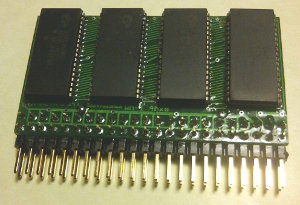
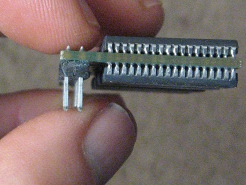
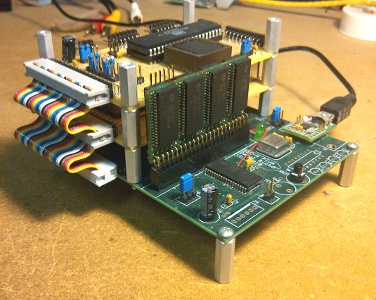
Wilson Mines Co.
• 6502 (& related) microprocessor articles, primers, tutorials, and links (Site's #1 purpose)
• electronics modules for hobbyists, for easing the construction of
home-made computers
• HP-41 calculator/computer links (more than 90), plus Forth, particularly on 65xx
The links page is my "second front page." Again: The main purpose of the site is information
dissemination. I'm constantly straining to make software more efficient, capable, maintainable, etc., and to demonstrate
what can be done with simpler hardware. The modules I offer are ones I designed for my own use and figured I might as well
make them available to others as well, to promote our interest. Goals for a home-made computer tend to quickly become too
lofty to carry them out in your lifetime, or change faster than you can build. It helps to have various sections ready-made.
The first module is WM-1, a 32Mb 4Mx8 5V 10ns SRAM module. Data sheet here. Email me at wilsonminesBdslextremeBcom (replacing the B's with @ and .) to buy. The module is 2.3" long, and is available with 90° pins (shown first, and it makes the module stand perpendicular to the mother board), or straight (shown second, and which puts it parallel to the mother board), or now also with rows at .300" spacing (shown third). Specify your preference when ordering.



This is the densest, fastest 5V SRAM module that I know of, and its pin header makes it hobbyist-friendly. When fully populated, it has 64 times as much RAM as the Commodore 64 did, and 32 times as much as the original Mac did. Being SRAM, it is free of the complications of DRAM management requirements. There's more discussion of it on the forum here. Daryl Rictor's SBC-4 computer which he sells (pictured above) uses it. I can provide the sockets too, both in soldertail (for $2.89 each) and in wire-wrap (for $5.50 each).
The price has gone up and down with the price of the ICs. I've been getting the ICs in quantity from a legitimate Cypress distributor in the U.S. for less than half of what you would probably have to pay for just a few. (I won't use Chinese or eBay distributors, as I've been burned before.) In the first week of April of 2020 however, I went to buy more, and the price had more than doubled, and although it was still in production, there was no stock anywhere which makes me think some contractor is probably buying them up faster than they can be made. The ISSI IS61C5128AL-10KLI was recommended as a substitute. After comparing the data sheets in detail, I concluded that the several differences (mostly improvements over the Cypress part) were too minor to affect the hobbyists who would be buying the module. Further, the ISSI part is much cheaper than the Cypress part would cost me now, so I've gone to the ISSI part. The module data sheet linked above reflects this. The ISSI SRAM's data sheet is here (.pdf). The ISSI part is about $0.75 more per piece that I had been paying for the Cypress one though, so I'm raising the price for a fully loaded module (ie, with 8 ICs) from $69 to $75. Add postage of course, and sales tax if going to a California address. (Add $10 more if you want .300" row spacing, because of the extra labor involved in improvising the connector.) Partially loaded modules are available for less.
Payment method
Options are Paypal, personal check, cash, or even bitcoin (email me for the public key).
Since I'm not here for the money, if you send a check, I might just go on the honor system, ie, not wait for
a check to clear, especially for the smaller products. It would be quite a loss if you abuse that for SRAM modules though!
Postage to U.S. addresses in March 2024 is $10.40 for USPS Priority Mail small flat-rate box. Postage for things like bare boards
that can go in a padded envelope by First-Class mail will be much less. If you're interested in buying something, contact me,
and we'll figure something out.
Next is WM-2A, a tiny SPI-10
flash or FRAM memory module, again very hobbyist-friendly. The board is made for W25X40CL, 25VF016, 25VF032,
26VF032, 25VF064, 26VF064, CY15B104Q or any other SPI flash or FRAM ICs in a normal or wide SO-8 package with the same pinout.
(The 32's are four megabytes, and the 64's are eight.) There's a one-page .pdf data sheet
here. I have sample SPI bit-bang code
here although it does not have code specific to operating the flash ICs.
Here in the picture are:
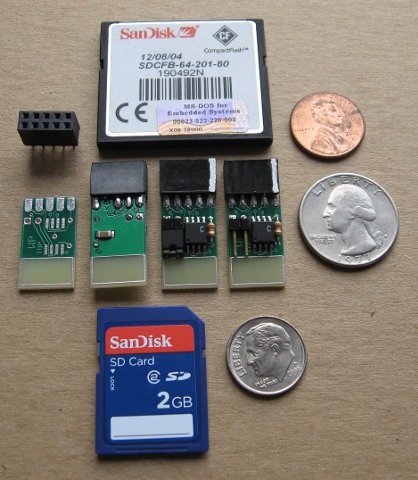
Granted, 4MB or 8MB is not much storage compared to what comes in CF of SD cards; but it's quite a bit for a 6502 system where you won't be storing videos or doing photo editing and probably won't even be listening to music on it. It's much easier to work with in terms of writing your own software drivers, and also cheaper than the standard consumer-electronics memory cards. You can make your own file system, or use them with no file system at all (as in my first use of one, for recording audio, in a loop).
I have not decided how to price these. The price of the bare board will be well below that of the IC, probably even including shipping if it's to U.S. addresses. As for selling pre-assembled units: The amount of assembly time required is fine for small quantities for personal use, but if I assemble them for others, I'd probably need to charge more than they will want to pay; so I might just sell the bare boards, with an exception for the few customers who can't see well enough to assemble one, or have other limitations. As with any boards, a large-enough order would justify the set-up cost for automated assembly, reducing the price of completed modules. Email me to buy.
Next is WM-5, a tiny I2C-6
EEPROM module, again very hobbyist-friendly. It uses a 24C256 32Kx8 I²C EEPROM in SO-8 package.
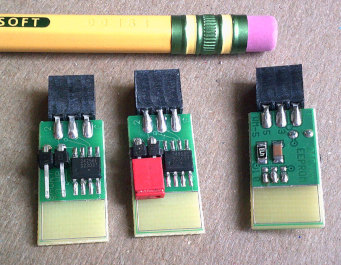
Overall size is .450"x1.225" including socket and pull-tab/label area. Data sheet is here (.pdf). I²C is very easy to bit-bang if necessary, and I have sample code in multiple forms here. The assembly work and the postage will probably dwarf the cost of the parts; so if you want to buy, email me and tell me how many you're interested in, whether you want completed modules or just boards, and where to ship to, and we'll figure out an appropriate price.
Next is WM-3A, a bit-I/O module with 8 input bits and 8 output bits, intended for where
bits are twiddled or tested independently of others in a group. It's faster and more code-efficient than doing it with a
VIA (although it's intended to augement, not replace, the VIA). It requires neither RMW instructions,
nor AND nor ORA instructions, nor altering A, X, or Y. It can be used as an IC, but takes only as much board space as a
16-pin DIP.
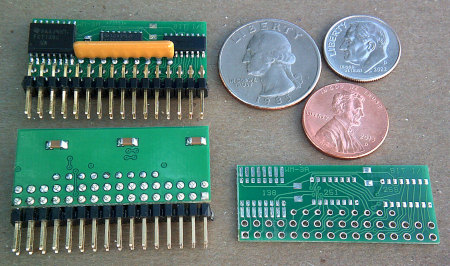
Overall size is 1.600" x 0.680", not including the pin header. Data sheet is here (.pdf). The idea came from the book "Advanced 6502 Interfacing" by John M. Holland, first edition, pages 37 & 53. Use the information in the data sheet to make your own on your board, or you can buy mine as a module to plug into your board.
Next is WM-4b, a 65SIB
breakout board to use on 65SIB devices.
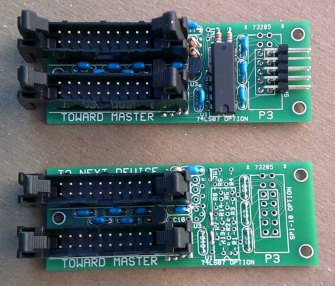
The reason for it is that after we developed 65SIB on the 6502.org forum, I made a peripheral with the small graphic LCD and an SPI flash, and found it was a lot of work to wire up the connectors, regulator, and do the voltage translation to 3.3V. The breakout board takes care of all that, and has lots of stuffing options for voltage regulators, interfacing to 5V, 3.3V, or 2.5V parts, and more. The data sheet, with all the information on various stuffing options, is here (.pdf).
Expected soon:

It uses a PIC microcontroller. (It is developed and working, but I need to finish the documentation.)
Also available: 1Mx8 EPROM pairs (27C801 in 32-pin windowed DIP) pre-programmed with the large
look-up tables for hyper-fast, accurate 16-bit math on any 8-bit computer. See the articles linked for info. I have some that were
graciously donated and programmed by Tony Gonzalez (Nightmaretony, an esteemed member of the 6502.org forum, who unfortunately died with cancer
in his 40's on 11/4/12), so until those are gone, your cost is only the shipping cost. (If you want to do your own, or load the tables into
RAM, the Intel Hex files are available at the link.)
And: I have 110 6512 microprocessors I bought in the mid-1980's for a project I never went through
with, to make an inexpensive SBC for education, hobby, and light industrial applications. The 6512 is a 6502 whose Φ1 pin is an input
rather than an output, and you would normally drive the Φ0 and Φ1 inputs using both the Q and Q
outputs of a 74xx74. The 6512 also has a DBE (data bus enable) pin (pin 36). The data sheet says, "This input allows external control
of the three-state data output buffers and will enable the microprocessor bus driver when in the high state. In normal operation DBE would be
driven by the Φ2 clock, thus allowing data output from microprocessor only during Φ2." It also says this external-clock version is "geared for the multi-processor system applications
where maximum timing control is mandatory." (It can be used in a single-processor system too though of course.) Make me a reasonable
offer for some or all of them. I could sell them one at a time, but I prefer not to.
There's a brief write-up on how I got into home-made workbench computers, microcontrollers, and automated test equipment,
with links, in my "Introduce Yourself" post, the first
one in the topic. I am very active on that forum, and also have some articles on 6502.org. I have a similar write-up
here on how I got into HP calculators as equipment controllers on the workbench,
which influenced my own home-made workbench computer designs.
The average time between updates on this site is a few days.
For 500+ links to materials on:
added 6/6/21: The 65816 microprocessor: Common Misunderstandings, Plus Attractions
added 6/16/19: Self-modifying code on 65xx
added 11/6/17: My workbench computers
added 10/1/15: 6502 stacks treatise 6502 Stacks: More than you thought! (actually a set
of 19 articles plus appendices, covering many aspects)
added 7/15/15: NMOS v. CMOS 6502 differences
added 6/9/15: Assembly Language: Still Relevant Today (article, not tutorial)
added 2/21/15: zero-overhead forth interrupt service on 6502.
I put it on 6502.org 12 years earlier, and it will
remain there too; but it's much easier to edit on my own site.
added 2/17/15: 6502 interrupts primer. I put it
on 6502.org 12 years earlier, and it will remain there too; but it's
much easier to edit on my own site.
added 5/16/14: simple methods for multitasking without a multitasking OS
added 7/28/12: program structures in 65c02 (and PIC16) assembly, through macros
added 6/25/12: 16-Bit scaled-integer math, hyper-fast and accurate, with large look-up tables
(provided) Plus: The unexpected power of scaled-integer math
added 4/27/12: 6502 PRIMER: Building your own 6502 computer (actually a set of 22
articles covering many aspects, some relating equally well to other processors too)
added 4/5/12: RS-232 primer
added 8/31/24: road-bike section (unrelated to computers and electronics)
This website gets about 1000 page downloads per day, 3000 files per day. The most popular section is the 6502
primer, followed by the section on 16-bit scaled-integer math and the large look-up tables. Many thanks to Andy Werner
("handyandy" on the 6502.org
forum) who proofread virtually my entire site!
page last updated Nov 18, 2024 contact: Garth Wilson, wilsonminesBdslextremeBcom
(replacing the B's with @ and .) (southern California) No SEO spam!
Also, do not bother me about email lists and other marketing resources. I'm not interested. My site is for promoting our interest,
not for making money. The purpose of the site, and the reason I do it the way I do, are described here.
domain reserved 2/18/12 © Wilson Mines Co. 2012-2026